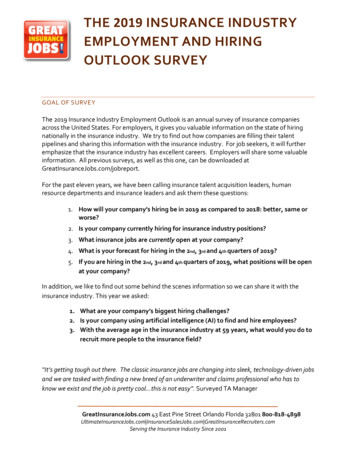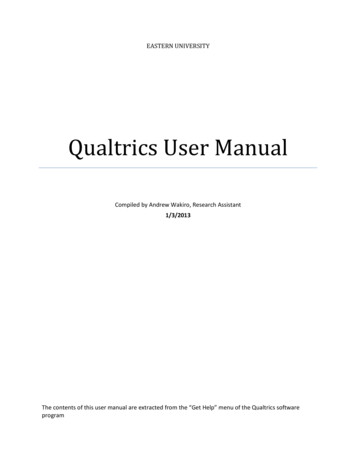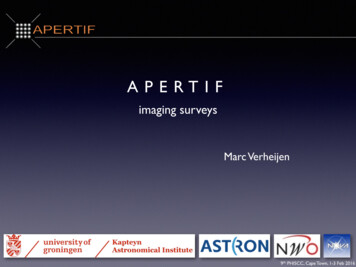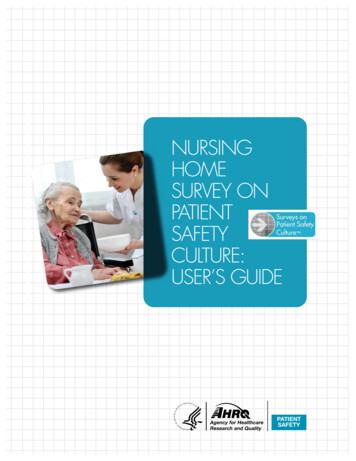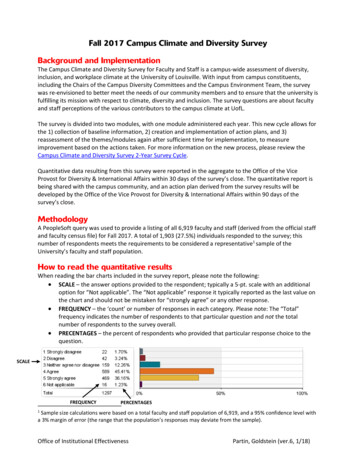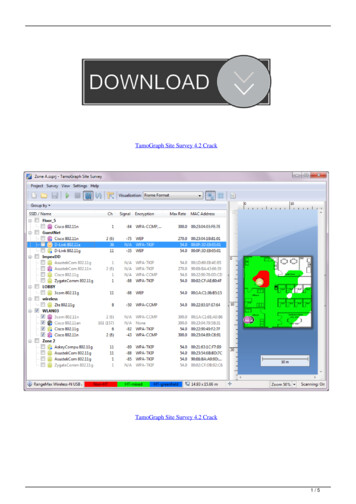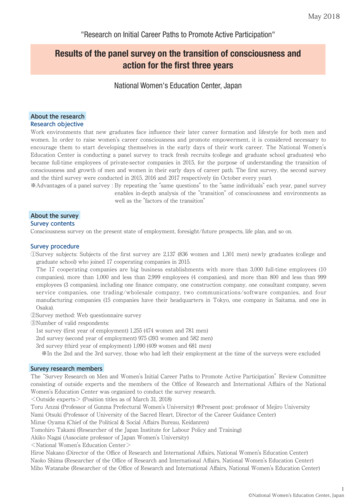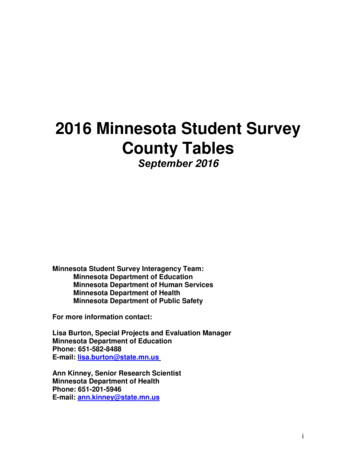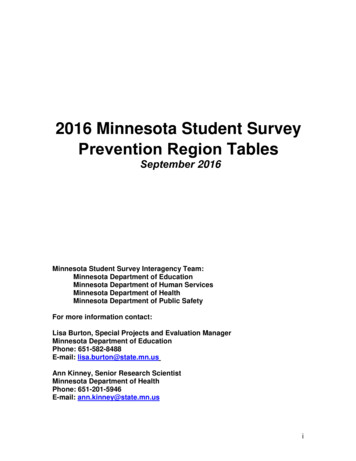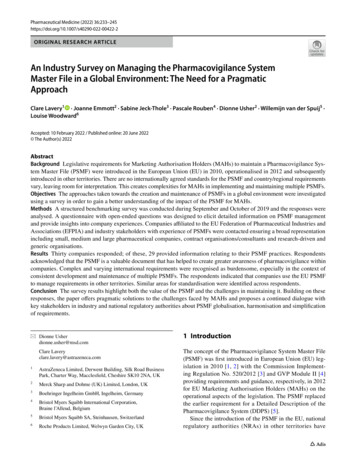
Transcription
Pharmaceutical Medicine (2022) 22-2ORIGINAL RESEARCH ARTICLEAn Industry Survey on Managing the Pharmacovigilance SystemMaster File in a Global Environment: The Need for a PragmaticApproachClare Lavery1 · Joanne Emmott2 · Sabine Jeck‑Thole3 · Pascale Rouben4 · Dionne Usher2 · Willemijn van der Spuij5 ·Louise Woodward6Accepted: 10 February 2022 / Published online: 20 June 2022 The Author(s) 2022AbstractBackground Legislative requirements for Marketing Authorisation Holders (MAHs) to maintain a Pharmacovigilance System Master File (PSMF) were introduced in the European Union (EU) in 2010, operationalised in 2012 and subsequentlyintroduced in other territories. There are no internationally agreed standards for the PSMF and country/regional requirementsvary, leaving room for interpretation. This creates complexities for MAHs in implementing and maintaining multiple PSMFs.Objectives The approaches taken towards the creation and maintenance of PSMFs in a global environment were investigatedusing a survey in order to gain a better understanding of the impact of the PSMF for MAHs.Methods A structured benchmarking survey was conducted during September and October of 2019 and the responses wereanalysed. A questionnaire with open-ended questions was designed to elicit detailed information on PSMF managementand provide insights into company experiences. Companies affiliated to the EU Federation of Pharmaceutical Industries andAssociations (EFPIA) and industry stakeholders with experience of PSMFs were contacted ensuring a broad representationincluding small, medium and large pharmaceutical companies, contract organisations/consultants and research-driven andgeneric organisations.Results Thirty companies responded; of these, 29 provided information relating to their PSMF practices. Respondentsacknowledged that the PSMF is a valuable document that has helped to create greater awareness of pharmacovigilance withincompanies. Complex and varying international requirements were recognised as burdensome, especially in the context ofconsistent development and maintenance of multiple PSMFs. The respondents indicated that companies use the EU PSMFto manage requirements in other territories. Similar areas for standardisation were identified across respondents.Conclusion The survey results highlight both the value of the PSMF and the challenges in maintaining it. Building on theseresponses, the paper offers pragmatic solutions to the challenges faced by MAHs and proposes a continued dialogue withkey stakeholders in industry and national regulatory authorities about PSMF globalisation, harmonisation and simplificationof requirements.* Dionne Usherdionne.usher@msd.comClare Laveryclare.lavery@astrazeneca.com1AstraZeneca Limited, Derwent Building, Silk Road BusinessPark, Charter Way, Macclesfield, Cheshire SK10 2NA, UK2Merck Sharp and Dohme (UK) Limited, London, UK3Boehringer Ingelheim GmbH, Ingelheim, Germany4Bristol Myers Squibb International Corporation,Braine l’Alleud, Belgium5Bristol Myers Squibb SA, Steinhausen, Switzerland6Roche Products Limited, Welwyn Garden City, UK1 IntroductionThe concept of the Pharmacovigilance System Master File(PSMF) was first introduced in European Union (EU) legislation in 2010 [1, 2] with the Commission Implementing Regulation No. 520/2012 [3] and GVP Module II [4]providing requirements and guidance, respectively, in 2012for EU Marketing Authorisation Holders (MAHs) on theoperational aspects of the legislation. The PSMF replacedthe earlier requirement for a Detailed Description of thePharmacovigilance System (DDPS) [5].Since the introduction of the PSMF in the EU, nationalregulatory authorities (NRAs) in other territories haveVol.:(0123456789)
234Key PointsThe value of the Pharmacovigilance System Master File(PSMF) and the commitment within industry to complywith the requirements are recognised and reflected insurvey feedback received from Marketing AuthorisationHolders.The responses also showed that complex and varyinginternational requirements are burdensome.The authors would welcome dialogue between industry and national regulatory authorities with respect toglobalisation of PSMF requirements, including theirsimplification and harmonisation.introduced similar legislation and/or local Good Pharmacovigilance (GVP) guidelines that include PSMF requirements (see Section 1.1.2. Other Territories).Whilst it is recognised that the PSMF has multiple benefits (e.g., internal/external oversight of the pharmacovigilance [PV] system, a central place for PV information,internal training purposes), pharmaceutical companies haveexperienced practical challenges in maintenance and implementation due to the varying requirements, their differentinterpretation and lack of global legislative harmonisation.To discuss the topic of managing the PSMF in theevolving PV landscape and to exchange best practices, theauthors (members of the PSMF Networking Group,1 hereafter referred to as the PSMF NG) have met regularly since2017 to evaluate and discuss the implementation of globalPSMF requirements, new and developing regulations andto check the mutual understanding of NRAs’ expectations.They conducted an industry survey in 2019 to better understand benefits and challenges, in particular when facing theglobalisation of PSMF legislation. The results of this surveyare reflected and evaluated in this paper, which summarises the findings of the survey and the PSMF NGexperience with regard to the construction and use of thePSMF globally; aims to create awareness amongst stakeholders of thepractical challenges for industry in addressing the globalrequirements; aims to open up discussion with all stakeholders including NRAs and share future considerations to driveC. Lavery et al.towards a global PSMF concept through harmonisation,simplification and reduced duplication of effort.1.1 Global Pharmacovigilance System Master File(PSMF) Legislation and Requirements1.1.1 The European Union (EU)The PSMF provides an overview of a company’s global PVsystem to contribute to the EU Qualified Person for Pharmacovigilance’s (QPPV) oversight and to the planning and conduct of internal PV audits. It is registered in the ExtendedEudraVigilance Medicinal Product Dictionary (XEVMPD)and provided upon request to support PV inspections byNRAs. The PSMF “should reflect global availability ofsafety information for medicinal products authorised in theEU, presenting information on the pharmacovigilance system applied at global, regional and local levels” [4]. Keyaspects relating to the PSMF content are provided in Table 1[4].The Implementing Regulation [3] and EU GVP ModuleII [4] provide a framework that allows flexibility to accommodate the different organisational structures of MAHs.However, the experience of the PSMF NG is of differinginterpretations by EU NRAs on the scope of the PV systemand information to be presented in the PSMF; for example,requests for study data or vendor presentation may vary, wetink signature requirements for PSMF-related documents,and NRAs may request a supplementary, ‘local’ version ofthe PSMF.One of the intended objectives for the PSMF, outlined inEU GVP Module II, was to reflect the PV system in placeand act as an oversight tool for the EU QPPV and NRAs.The experience of the PSMF NG is that through the evolution of MAH PV and quality systems in the time since 2012,including enhanced processes and mechanisms to assess andshare feedback on system performance, there may now beadditional ways in which oversight is provided to the EUQPPV/MAH Senior Management (e.g., participation inregular PV governance/compliance forums). However, thePSMF has undoubtedly contributed to improvements inoversight over MAH's PV and quality systems. It continuesto serve as a tool that offers systematic and holistic oversightof the PV and quality systems and their performance, andenables greater connectivity with other departments contributing to the PV system, thereby indirectly raising the profileof PV and PV compliance within companies.1.1.2 Other Territories1The PSMF NG is a subgroup of the European Federation of Pharmaceutical Industries and Association (EFPIA) focusing on PSMFrelated matters. The group was formed in 2017 and evolved tobecome an EFPIA working group in 2019.The PSMF concept continues to evolve in other territorieswith the introduction of requirements and/or expectationsfor a PSMF or equivalent document; examples include Arab
235Industry Survey on Managing the PSMF in a Global EnvironmentTable 1 EU PharmacovigilanceSystem Master File (PSMF):overview of currentrequirementsPSMF main body text1. QUALIFIED PERSON RESPONSIBLE FOR PHARMACOVIGILANCE (QPPV)EU QPPV details (responsibilities, curriculum vitae (CV), contact and back-up details)2. ORGANISATIONAL STRU CTU RE OF THE MARKETING AUTHORIZATION HOLDEROrganisational structure relevant to the PV system (organisation and delegated activities)3. SOURCES OF SAFETY DATA Main units for safety data collection4. COMPUTERISED SYSTEMS AND DATABASESRelevant to the PV system5. PHARMACOVIGILANCE PROCESSESDescription of PV processes6. PHARMACOVIGILANCE SYSTEM PERFORMANCE7. QUALITY SYSTEMRecord control, procedural documents, training, auditing, deviationsPSMF annexesSupporting information (e.g., tasks delegated by the QPPV, proof of registration in EudraVigilance)Contractual agreements and delegated PV activitiesSite details and contact information (lists associated with the description of sources of safety data e.g.,affiliates and third-party contacts)Supplementary information (to the section, if needed)List of procedural documents relating to PVPerformance indicators and resultsAudit schedules, completed auditsList of products covered by the PV System in the EU (including where the product is marketed outside theEU and product-specific safety monitoring requirements)Change logEU European Union, PV pharmacovigilance, QPPV Qualified Person for PharmacovigilanceLeague, Eurasia and India [6–8]. Requirements for a PSMFin the different countries follow the principles of oversight,PV system reflection and audit planning as introduced inthe EU, but they also frequently focus on country-specificinformation (e.g., inclusion of country organisational charts,country-specific lists for approved products, studies andlocal PV service providers).The PV regulatory landscape also continues to develop atdifferent rates across territories. In some regions the requirements may be driven by well-established PV departments ofa ‘lead’ NRA with other countries in that region just startingtheir development of a PV infrastructure, as described byAlshammari et al. [9]. Even where requirements have beenset at a regional level, individual NRAs within the regionmay insist on additional documentation such as countryspecific annexes, supplementary documentation, or translations in local language.The aim of this paper is not to provide a detailed overviewof the requirements in these territories. However, the PSMFNG’s collective experience of documents provided to comply with regulatory requirements are summarised in Table 2.From an industry perspective, an additional complexity is related to the varying document submission requirements across the countries/regions. These may include aPSMF kept on file and submitted only on NRA request, orsubmitted as part of a regulatory dossier (e.g., marketingauthorisation application [MAA], renewal), or submittedafter a major PV system change, or submitted annually, and/or a combination of any of these scenarios. It has also beennoted that regulatory requirements in certain regions appearto be aligned with previous versions of EU GVP Module II,for example the Eurasian Economic Region and Arabic GVPModules. The authors also note that, after the completionof the survey, further UK-specific requirements came intoforce in 2021 [10].1.2 SummaryBoth in and outside of the EU, it appears PSMF requirements vary because of interpretation, implementation status or actual country/regional requirements. Multinationalcompanies are challenged with the task of complying withthese requirements and interpretations. Manual adaptationand customisation of data reflected in the PSMF to addressthe requirements/interpretations are challenging, time consuming and duplicative and require quality control stepsto ensure the delivery of high-quality data. Harmonisationand simplification have the potential to reduce the burden ofPSMF maintenance and to create efficiencies in the processand therefore support and facilitate high-quality outputs.
236C. Lavery et al.Table 2 Other territories: authors’ experience of Pharmacovigilance System Master File (PSMF)-type documents required by local legislationDocument typeDescriptionCountry/regional PSMFFollows the same format as the EU PSMF but the content includes country/regional and global information on the PV systemCountry/regional Pharmacovigilance Sub-System File (PSSF) Describes the key elements of PV activities in the country concerned and issubmitted alongside the PSMFDetailed Description of the Pharmacovigilance System (DDPS) Based on Volume 9A of the Rules Governing Medicinal Products in the European Union: Guidelines on Pharmacovigilance for Medicinal Products forHuman Use requirementsProvides a description of the system with requirements for listings and compliance dataSummary of the Pharmacovigilance System (SPS)Terminology that, in the Authors’ experience, may have different meanings indifferent countries/regions. For example:a document based on EU GVP Module II requirements (proof of the applicant’s QPPV, residency and contact details of the QPPV, location of thePSMF and a signed statement that the applicant has the necessary means tofulfil the tasks and responsibilities listed in Title IX), ora simple descriptive written summary of the PV System within a companyEU PSMFAccepted where there are strong similarities with EU legislation/GVP. Of note,consideration should be given to the applicability of the EU PSMF content(e.g., responsibilities of the EU QPPV outside of this region)EU European Union, GVP good pharmacovigilance practices, PV pharmacovigilance, QPPV Qualified Person for Pharmacovigilance2 ObjectivesThe approaches taken towards the creation and maintenanceof PSMFs in a global environment were investigated using asurvey in order to gain a better understanding of the impactof the PSMF for MAHs.3 MethodsInformal exchange within the PSMF NG revealed that companiesaim to comply with the various expectations and requirements,however they have different approaches to achieve this. Anindustry benchmarking survey was conducted during Septemberand October of 2019 by the PSMF NG to better understand thevarious approaches taken across industry towards PSMF maintenance, as well as the influence of the EU PSMF model on theproduction and maintenance of PSMFs outside the EU.For this paper, a qualitative approach was taken; a targeted questionnaire (survey) was used to obtain informationabout the PSMF experience (primary information related toexperience of industry subject matter experts). Open-endedquestions were developed allowing free-text responses.Survey responses were solicited for EU and other territories’ perspectives; questions were included on the following: Frequency of PSMF updatesAdaption of the EU PSMF for use outside the EUFeedback received from NRAs in other territoriesBenefits and use of the PSMF Challenges of PSMF maintenance Proposals for improvement and globalisationOpen-ended questions were designed to elicit detailedinformation and provide insights into company experiences.The intention of the survey was not to generate statisticalresults, but rather to obtain structured information on experiences from day-to-day work, inspections and/or feedbackfrom NRAs.Companies affiliated to EU Federation of Pharmaceutical Industries and Associations (EFPIA) and industry stakeholders with experience of PSMFs were contacted, ensuringa broad representation including small, medium and largepharmaceutical companies, contract organisations/consultants and research-driven and generic organisations. Invitations to participate in the survey were routed to EU QPPVsand/or PSMF Managers or their delegates, and respondentswere requested to complete the survey in a Word document by return email. Respondents were informed that theirresponses would support this paper.All responses for the survey were anonymised, and aggregated by the PSMF NG, as communicated upfront to thesurvey respondents.4 ResultsThirty companies responded; of these, 29 provided information relating to their PSMF practices. Figure 1 showsthe breakdown of respondents by company type and size.
237Industry Survey on Managing the PSMF in a Global EnvironmentFig. 1 Type and size of surveyrespondents. CRO contractresearch organisation, SMEsmall and medium-sized enterpriseLarge Pharma (n 20)Pharma SME (n 4))CRO/Consultant, Large (n 2)CRO SME (n 3)Twenty-four companies were identified as pharma, theremainder being contract organisations/consultants producing PSMFs on behalf of clients. Using the European Commission definition [11], seven respondents were small tomedium sized (SMEs) and 22 were large enterprises ( 250staff headcount).4.1 Management of PSMF GloballyThe survey asked about companies’ approaches to PSMFmaintenance (i.e., in-house or outsourced) and updatefrequency (Fig. 2). The results reflect variability in theapproaches but demonstrate that all responding pharmacompanies manage these documents in-house and performupdates on a regular basis, often quarterly. Update of theEU main body text mostly occurs in parallel with the EUannexes, although some companies noted that they maintain a variable approach to annex updates, for example,depending on size, type and complexity of the annex. Contract Research Organisations’ (CROs’) approaches appearto depend on client requirements. The majority of the companies also update their PSMFs in non-EU territories on aquarterly basis, although the approach appears even morevariable than that used for EU updates.Figure 3 provides an overview of how companies utilisethe EU PSMF for countries outside the EU. The information provided by 21 respondents demonstrates heterogenousapproaches such as the format they choose and the detailsthey include, however the majority modify their EU PSMF.Two companies noted that they produce a single, globalPSMF with information for all countries with applicablelocal information placed into additional annexes. One ofthese companies noted that the main body text is providedas a ‘standalone’ document. Three companies stated thatlocal information was ‘appended’ to the EU PSMF as subfiles or annexes, submitted together. This information couldinclude, for example, details on the country QPPV, localorganisations, standard operating procedures (SOPs), product lists and metrics.Over half of the respondents modify the EU PSMF, beit the main body text, the annexes or both. Table 3 demonstrates the types of modifications, as provided by ninecompanies (more than one may have been indicated by asingle responder).While the modifications vary, there is a trend to use themain body text and/or annexes of the EU PSMF describing the global PV system, and supplement this with localinformation in accordance with the company’s understanding of local requirements. In the examples given,companies provide the main body text from EU PSMFSects. 2–7 along with some EU PSMF annexes. Affiliatesmay then complete their PSMF by adding local information, for example on the country QPPV, metrics and localSOPs.Only five participants indicated that they had submitteda PSMF (EU or localised PSMF) to the NRAs in other territories. Without providing details, one indicated that theyhad received feedback on the PSMF from a NRA.4.2 Globalisation of the PSMF—IndustryChallengesSurvey participants were asked to comment on the three biggest challenges of operationalising and implementing PSMFrequirements globally. The answers have been grouped intocategories for ease of review. Additional detail from theanswers has also been included, where possible, for somecategories. The results for both EU and other territories areshown in Figs. 4, 5.4.3 Industry‑Perceived Value of the PSMFThe survey asked respondents to share thoughts on the valueof the PSMF. Respondents provided the following examples:
238C. Lavery et al.1614121086420EU Core DocumentEU Annexes ResultsOther Territories PSMFQuarterly6-monthlyMonthlyYearlyEvery 4 monthsVariableBi-monthlyDo not maintainNo responseDependent on country requirementsFig. 2 Company approaches to maintenance of the Pharmacovigilance System Master File (PSMF) [N 29 survey responses]. EU EuropeanUnionFig. 3 Company adaptationof the European Union (EU)Pharmacovigilance SystemMaster File (PSMF) for use outside of the EU [N 21 surveyresponses]14121086420Modified EU PSMFmain body text/Annexes for the EU QPPV (e.g., enhancing cross-functional links,tool for training on the PV system); for the company (e.g., centralises, drives quality of compliance data and database outputs); other (e.g., inspection readiness as PSMF componentscan be used to fulfil pre-inspection requests).Other (detail notprovided)Local sub-file(s)Global/StandaloneAppended to EU PSMFPSMF CoreMost of the respondents indicated that the EU PSMFand that of other territories are valuable in providing oversight of the PV system, supporting PV audit planning andthe preparation and conduct of PV inspections, as intendedin the legislation. Additional value includes training fornew colleagues, a document/process to drive quality and
239Industry Survey on Managing the PSMF in a Global EnvironmentTable 3 Modifications to theEU Pharmacovigilance SystemMaster File (PSMF)aModification typeSurvey resultProvision of EU PSMF main body text, Sections 2–7Reorganisation of EU PSMF annexes and/or provision of specific local annexesRemoval of reference to EU-specific informationProvision of some EU PSMF annexes (global information)Provision of a company-developed template based on EU PSMFNo EU PSMF annexes providedCreation of specific local section 1 for main body text4433221a Where information provided, n 9EU European UnionFig. 4 What value does thePharmacovigilance SystemMaster File (PSMF) add?181614121086420EU PSMF Survey Result (n 29)Other Territories PSMF Survey Result (n 21)Oversight/OverviewInspec ons /AuditTrainingQualityCollabora onCentralisa on of informa onManagement of PV Systemcompliance, and enhancing cross-functional activities withinthe organisation.One respondent noted that, while the EU PSMF providesa good oversight of the PV system and its performance, thereremains the “danger that too much [information] is includedand oversight is lost”. Three other respondents noted that thebenefit of other territories’ PSMFs may be limited and/oroutweighed due to the burden of their maintenance.suggestions to include local data such as local/regionalQPPV information and local listings in annexes.A few comments related to consistency of regulatoryguidance and expectations, such as suggesting a commontemplate as well as alignment of requirements. There werealso comments suggesting improvements industry couldmake, such as automating information gathering.4.4 PSMF Globalisation5 DiscussionThe final question asked for recommendations for a trulyglobalised PSMF. Table 4 shows the diverse responses, withover two thirds relating to the PSMF structure, in particular regarding the main body text and some annexes, withOverall, there is a clear commitment from the survey participants to operationalise and provide the PSMF in compliance with the respective regulatory requirements and NRAexpectations. The results highlight the different approaches
240C. Lavery et al.Fig. 5 Challenges of EuropeanUnion (EU) PharmacovigilanceSystem Master File (PSMF)production [N 29 surveyresponses]9%3% 1%23%14%17%16%17%Obtaining DataInterpreta on of the Scope of Data in the PSMFSystem Capabili esAccountability for Informa on ProvidedData Quality & AccuracyTime to CompileComplexityGDPR Aspectstaken for PSMF maintenance and the challenges with theglobalisation of the PSMF. While there is variability in theapproaches due to issues like local requirements, companystructure and portfolios, or company assessment of legislation, there is commonality in thinking. This is evidencedin the 29 responses demonstrating that most companies areutilising and/or adapting the EU PSMF process and documents to meet requirements in other territories. Suggestions for standardisation also appear to be similar across theresponses received.It has been over 10 years since the introduction of PSMFrequirements in EU GVP Module II. The challenges facedby industry in the preparation and maintenance of the EUPSMF, as discussed in various industry fora (e.g., DIAworkshops in November 2019 and November 2020), arewell reflected in the responses to the survey. The results inTable 5 indicate that obtaining data in a timely and efficientmanner from relevant stakeholders for the EU PSMF is achallenge across companies. The understanding and engagement of contributors, in particular outside the safety function, can be key to the provision of accurate data. The qualityof data included in the source systems is highlighted as anadditional challenge: company systems/databases may notbe set up to provide data specifically for the PSMF, they maynot contain the required data or data may need to be pulledfrom multiple systems with a potential lack of harmonisationacross systems.The survey demonstrates that the introduction of PSMF legislation in other territories brings additional challenges and theoperationalisation of the PSMF maintenance process becomesmore complex. Some countries have incorporated elements ofEU GVP Module II into their legislation without implementingthe revisions. The complete PSMF may be requested in otherterritories outside the EU as part of regulatory dossiers andlicence renewals; a purpose not foreseen in EU GVP ModuleII. The approaches taken across companies are heterogenous:some territories outside the EU accept the EU PSMF, somecompanies provide the EU PSMF main body text only, somethe summary of the applicant’s PV system. This lack of harmonisation, difficulties in interpretation and tracking of legislationin other territories and NRA expectations is burdensome, leading to intra- and inter-company inconsistency.Producing PSMFs to meet the varying legislation acrossthe globe raises challenges for industry, in particular, how toensure consistency and scale up production. Large pharmacompanies may have developed systems or programmes toenable standardised and quick retrieval of data, addressingany country-specific need. However, respondents indicatethe obvious resource burden.The results from the survey nevertheless clearly demonstrate the value placed by industry on the PSMF. Severalrespondents identified the PSMF as a “critical”, “great” or“useful” tool and indicated that the utilisation of a PSMFcan extend beyond the original purpose. The description ofthe PV system contained in the main body text providesa useful central resource of information for functions outside of safety as well as all new starters to demonstrate therole of the company’s PV system. Many respondents (seeTable 4) noted that the PSMF helps to drive quality andcompliance through identification and resolution of processgaps, streamlining of PV activities across functions, and theregular review of systems and processes. Furthermore, thePSMF has helped to raise the profile of PV in global functions and affiliates, due to the cross-functional collaboration.
241Industry Survey on Managing the PSMF in a Global EnvironmentTable 4 Recommendations Suggested for Pharmacovigilance System Master File (PSMF) GlobalisationResponses provided regarding the structure of the PSMF Survey result Suggestions include:(some responses provided more than one approach)Global/harmonised main text part9Country-specific annexes9Global PSMF format8Modular approach where sections could be removedbased on legislation4Other2Other comments: legislative expectations/guidance4411Other comments: company process1111Main text content to focus on the global PV system description, moveall country-specific information into the annexesHarmonise main text content with existing regulationsStructure with fixed and harmonised modules for global and localsectionsHarmonise main text content for global useInclude all country-specific information in annexesMove all QPPV information into the annexAs far as possible, achieve global agreement on the core list of annexesrequired (recognising there will be a need for some local/regionallistings)Make the data requirements non-country/region specificTo cover all products globally and add filters to annexesMove QPPV and any local details into an annexInclude ‘placeholder’ annexes, where local information could behousedFlexibility to pull out local metrics/KPIs where needed and if systemspermit to satisfy local regulationsCommon template of the main body text available across pharma companies with clear scope on what to include and what not to include.All varied information could be part of the annexesSection 1 as a separate section/annex for each country/regionPersonnel/product-specific information in an annexPut in place a common template across companies and guidance/scopeAlignment of NRA requirements and expectations (e.g., presentingaudit findings and deviations)Training of NRAs outside the EU on their understanding of the PSMFconceptLocation of the PSMF should not be relevant, as long as the QPPV canaccess the document electronicallyAutomate processes to obtain informationObtain information in the most direct way possible and without intermediariesHave a list of local PV contacts
Background Legislative requirements for Marketing Authorisation Holders (MAHs) to maintain a Pharmacovigilance Sys-tem Master File (PSMF) were introduced in the European Union (EU) in 2010, operationalised in 2012 and subsequently . the paper oers pragmatic solutions to the challenges faced by MAHs and proposes a continued dialogue with .



